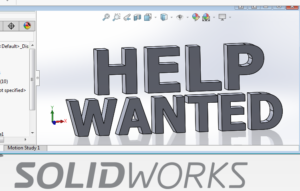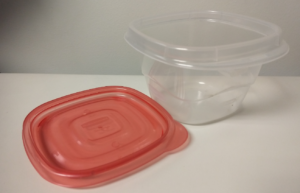
You’re hiring for a new technical position and you’re looking for a SolidWorks skills in the candidate? You’re not alone. CAD is the #1 requirement for mechanical design professionals and Solidworks is the #1 CAD software as far as usage. This is the guide to getting the right person for the job you need done. I’ve developed this after years of being part of the hiring process of several engineers and CAD drafters. I’ve seen this done wrong, and it can be disastrous. Taking staffing shortcuts invariably leads to costly production delays/errors, loss of department credibility and project stagnation. The three steps in the process are:
#1 Confirm all the job requirements
Most companies grab a job definition from someone else’s job post. I’m all for efficiency, and it’s great to start with something but make sure not to be overly restrictive. Can that a “Must be a degreed mechanical engineer” be “mechanical engineer or similar degree and/or experience”? Do you really need someone with 2-3 years of experience in your industry, or would another industry bring in some new perspectives? I’ve seen too many good candidates get filtered out because of unnecessary requirements. It’s better to keep it open. The honest and diligent candidates won’t apply if they don’t meet all the criteria listed on the job posting.
#2 Invite applicants and start screening
Depending on the level of the position I’m hiring for, I’ll go to different sources. For entry-level, I almost always go to professors that I’ve developed relationships with at local universities. A few free lunches generally gets me the top students in work-ethic and attitude. It’s also a great way to get interns. And I’ve always felt a good intern program is like a feeder-system for our engineering department.
If the position is a mid- to high- level engineer, I’ll ask for referrals, but also draw from LinkedIn. I generally don’t get to offer a relocation package, so I don’t like posting a position on Monster or Indeed. Sometimes I’ll post on Craigslist.
Generally, I’ll set up job posts until I screen through about 300 resumes. With my first review, I get it down to 10 candidates. This takes me about two to three hours. Yes, that’s less than one minute per resume.
Whenever I see something on a resume that concerns me, I just eliminate the candidate. Most resumes take less than 10 seconds. I’ve seen recent grads that claim they have 10,000 hours on Solidworks. That’s 50 hours/week for four years… and that that resume goes straight into the trash. I read all cover letters. Some are generic form letters. That’s fine- but doesn’t really impress me. If you actually have looked up my company and have something unique to say about how you fit with our products- that may get you a bit longer of a review. I have seen errors on the form letters (like saying “I’m really interested in working at Disney” when I’m hiring for another company). Those applications get dumped too. You may think this is petty- but attention to detail is a critical engineering attribute.
I will say that when I see a SolidWorks credential (such as CSWA, CSWP or CSWE), it makes me take another look. These certifications are generally only known within the circle of people who use SolidWorks regularly. The Certified SolidWorks Associate (CSWA) status is good for foundational skills. The Certified SolidWorks Professional (CSWP) is good for intermediate skills. The Certified SolidWorks Expert (CSWE) is good for advance skills.
The second screen is to look the person up on social media- mostly LinkedIn and Facebook. This only takes about 3 minutes per candidate, and I’ll usually bump 2-3 off the list based on it. What do I look for? Possible problems & positive personality. People that are very politically active or very outspoken may have issues in a team environment. People going through major issues (like divorce or bankruptcy) could distract them from the work that I need to get done. Please see it from my perspective- while I’d like to be charitable, why bring problems in? If the candidate volunteers or does outdoor activities or has interesting side hobbies, those are pluses (and great conversation starters to open a candidate up during an interview).
The third screen is a phone interview. When you reach out to these candidates, ask some challenging questions like: What have you done? Ask for specific details. How have you handled a difficult situation? This takes my list of 8 or so down to three people in about two hours.
At that point, I’ll generally bring in all of them for an interview.
Remember, you eventually want to work with one of these people, so it’s not about intimidation. It’s about seeing if the job is a good fit, and it will only work if both of you feel like it’s a good deal.
Step # 3- Test
Solidworks is a skill set that needs to separately tested. Do not assume that the resume accurately reflects their ability. Virtually every engineer and design student has touched some form of CAD and will have it on their resume. I’m not sure why, but some technical people just aren’t fascinated by CAD. If it is a critical part of their job function, you should check their level of proficiency. Please note, this is for testing core skills in modeling only. We aren’t testing specialty skills like simulation, surfacing or sheet metal. Also, we aren’t having them brainstorm an idea or a solution. That is a completely different skill set, and should be evaluated separately.
The two tests that I give are to model a part and to review a drawing. I give them the first test for 15 minutes (on the computer), then I give the second test for 5 minutes (handing them a drawing to review while I look at their part). Then we discuss for about 30 minutes. At that point, I’ll introduce them to other people (perhaps have them interview with them) and give them a tour of the facility.
For the first test, my format is usually to give them a relatively simple looking mating parts (that have lots of details), a pair of calipers, a ruler and 15 minutes. Those parts usually have thin features, draft and some great rounds. My favorite go-to is a low cost food storage container.

The key here is to give something that can’t possibly be completely done within the given time frame.
The most important part is the follow-up conversation. Use it as a conversation piece and let them do the talking. For the first modelling test, here are the leading questions I use (and what I’m listening for):
“How’d it go?” Do they give you excuses? Do they smile because they are confident in their skills and did they like the challenge? Note: I don’t eliminate anyone because they screwed up building the part. I do like using it to see how they respond to pressure.
“Why did you do this?” How do they handle criticism? Can they defend themselves or do they flop over? Are they okay with admitting failure? Did they put any design intent in? Is the design robust? One candidate I had got stuck about after 3 minutes, and didn’t do anything else. Is that the kind of guy you want? Someone who won’t just try something?
“How would you manufacture this? What material is this?” Do they know anything about manufacturing?
“How long would it take you to finish this part?” Are they good at estimating time? Do they under-promise and over-deliver?
For the second test, I generally find a one page part drawing that has already gone through approvals. I’ll put a couple of different types of errors in there just to see what they catch (usually one redundant measurement, one spelling error and one inconsistent notation). If they catch those easy “mistakes”, great- but I really hope that opens them up to talk about broader topics like best practices for drawing layout, and what kind of information would the quality department need, and what would be helpful for manufacturing. Again- the key is to let them do the talking. Ask leading questions like: What do you think of this tolerance? How would you measure this dimension (if you were inspecting the part)? Should it be removed, or put as reference only?
That’s what has been working for me. Would love to hear your thoughts. Feel free to shoot me an email.
________________________________________
About the Author

Jim Lucas is currently a design engineer at a company that focuses on disposable medical products and alarms. He can be reached at Jim.Lucas@i-elf.com.

I started my CAD experience in CGI film work. When I eventually went to mechanical engineering school, the CAD class that I was required to take was an absolute no brainer. Upon graduating, I have applied and interviewed at a world’s record amount of companies to do CAD. I show them my portfolio, but the typical response is that it is “artwork” with no dimensions. How should I respond to this? Adding dimensions to geometric shapes is not hard. I am faced with this problem despite now having actual job experience.